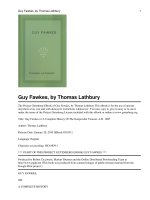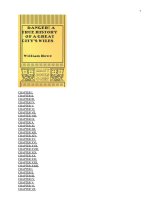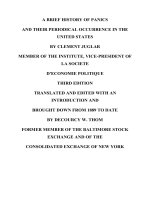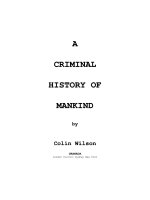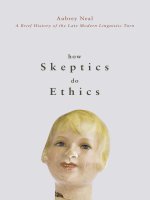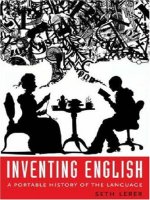hillbilly a cultural history of an american icon
Bạn đang xem bản rút gọn của tài liệu. Xem và tải ngay bản đầy đủ của tài liệu tại đây (7.09 MB, 338 trang )
Hill
billy
A Cultural History of an American Icon
Hill
billy
Anthony Harkins
1
2004
1
Oxford New York
Auckland Bangkok Buenos Aires Cape Town Chennai
Dar es Salaam Delhi Hong Kong Istanbul Karachi Kolkata
Kuala Lumpur Madrid Melbourne Mexico City Mumbai Nairobi
São Paulo Shanghai Taipei Tokyo Toronto
Copyright © 2004 by Oxford University Press, Inc.
Published by Oxford University Press, Inc.
198 Madison Avenue, New York, New York 10016
www.oup.com
Oxford is a registered trademark of Oxford University Press
All rights reserved. No part of this publication may be reproduced,
stored in a retrieval system, or transmitted, in any form or by any means,
electronic, mechanical, photocopying, recording, or otherwise,
without the prior permission of Oxford University Press.
Library of Congress Cataloging-in-Publication Data
Harkins, Anthony.
Hillbilly : a cultural history of an American icon / Anthony Harkins.
p. cm.
Includes bibliographical references (p. ) and index.
ISBN 0-19-514631-X
1. Mountain people in popular culture—United States. 2. Whites in popular culture—
United States. 3. Popular culture—United States. 4. United States—Civilization.
5. United States—Race relations. 6. Group identity—United States. 7. Whites—
Race identity—United States. 8. Mountain people—United States—Public opinion.
9. Whites—United States—Public opinion. 10. Public opinion—
United States. I. Title.
E184.M83H37 2003
975'.00943—dc21 2003041974
Portions of chapter 3 have been reprinted with permission in revised form from
“The Significance of ‘Hillbilly’ in Early Country Music, 1924–1945,” Journal of Appalachian Studies 2
(Fall 1996): 311–22.
Chapter 6 has been reprinted with permission in revised form from
“The Hillbilly in the Living Room: Television Representations of Southern Mountaineers in
Situational Comedies, 1952–1971,” Appalachian Journal 29 (Fall 2001–Winter 2002): 98–126.
987654321
Printed in the United States of America
on acid-free paper
To Charles R. Harkins
In Memoriam
This page intentionally left blank
This work is appearing in print largely because of the support and ex-
pertise of the editorial staff at Oxford. I thank Niko Pfund for his unflagging
commitment to this project, Susan Ferber for her unparalleled editorial sug-
gestions as well as calm guidance, and Stacey Hamilton for her assistance
with the book’s production. I also thank the outside readers of the original
manuscript, both those who remained anonymous and those who did not
(Dwight Billings, Erika Doss, David Hsuing, and Scott Sandage), for their in-
cisive commentary and suggestions. My efforts to address their concerns and
to reach for what they saw as the project’s full potential has made this a far
better book.
I am also deeply appreciative of the many individuals who have shared
difficult to find or unpublished materials with me, often allowing me to see
their notes for their own forthcoming publications. First, I owe an enormous
debt of gratitude to Jerry Williamson. Going far beyond the bounds of mere
scholarly collegiality, Jerry opened up to me his vast collection of hillbilly-
related materials, allowing me to roam at will through his extensive files and
view his copies of rare films. He also freely offered his valuable insights into
the hillbilly identity, helped me find accommodations during my stay in
Boone, North Carolina, and has continued to offer his invaluable support
and insights in the ensuing years. I am extremely grateful to him for his many
kindnesses and suggestions. I also thank the following people who all pro-
vided me with their own scholarly work or other research materials: Terry
Bailes, Tom Bené, Simon Bronner, Jim Clark, Stephen Cox, Jon Harris, Tom
Inge, Angie Maxwell, Michael McKernan, John McCoy, Ronnie Pugh,
David Whisnant, Adam Wilson, and David Zercher. Finally, I am most ap-
preciative of Paul Henning’s willingness, despite health problems, to partici-
pate in an extended telephone interview. His candor and infectious warmth
in recalling his years working on The Beverly Hillbillies and other program-
ming made for a thoroughly enjoyable and informative conversation.
This research project has entailed significant expense in acquiring il-
lustrations and republication permissions and traveling to far-flung archives
and libraries, and I gratefully acknowledge the institutional support and re-
search assistance I have received. My sincere appreciation to the University
of Wisconsin-Madison’s Department of History for research travel and con-
ference presentation funds and the Princeton University Committee on Re-
search in the Humanities and Social Sciences for their generous grant that
allowed me to acquire the array of artwork that enriches the text. I am grate-
ful to John Blazejewski for the expert job he did photographing the majority
of these images. I also wish to express my gratitude to the many librarians and
archivists who have assisted me along the way. In particular, I thank Stephen
Goddard of the Spencer Museum of Art, University of Kansas; Steve Green
Acknowledgments
viii
of the Southern Folklife Collection at the University of North Carolina-
Chapel Hill; Ronnie Pugh, formerly of the Country Music Foundation; Ned
Irwin of the Archives of Appalachia at Eastern Tennessee State University;
Dean Williams of the Appalachian Collection at Appalachian State Univer-
sity; Kate Black and Bill Marshall of the Appalachian Collection and Special
Collections at the University of Kentucky; Harry Rice and Gerald Roberts of
the Hutchins Library at Berea College; Ann Wright of the Asheville Public
Library; Randy Roberts of the Western Historical Manuscript Collection of
the University of Missouri-Columbia, and the library staff at Firestone Li-
brary of Princeton University. For assistance during my research in the Los
Angeles area, I thank Ned Comstock at the Cinema-Television Library at the
University of Southern California; the staff at the Margaret Herrick Library
at the Academy of Motion Picture Arts and Sciences (particularly Kristine
Kreuger); Brigitte Kueppers, chief archivist of Special Collections at the The-
ater Arts Library at the University of California, Los Angeles, and the ex-
tremely helpful proprietors of Eddie Brandt’s Saturday Matinee in North
Hollywood, California, for their great assistance in finding the many obscure
hillbilly films held in their vast collection.
My travels were made infinitely more enjoyable and affordable through
the kindness of friends and family who generously allowed me to stay with
them during my research trips. I sincerely thank Anne and Chris Kenyon, my
mother, Shanna MacLean, Harry and Katherine Petrequin, and David Zercher.
Above all, I am indebted to Andrew Cypiot for not only allowing me to stay
in his small apartment for over a month but also for conducting valuable re-
search for me. I could not have completed the California portion of my re-
search without his help and friendship.
Throughout the many years it took to bring this project to fruition, I have
relied heavily upon friends and colleagues for guidance and support. I am
very grateful that Susan Ballard, Steve Burg, Joe Cullon, Judy Cochran, Rob
Good, Dan Graff, Charlotte Haller, Katherine Ledford, Charlie Mont-
gomery and Linda Curchin, Paul Murphy, Doug Reichert-Powell, Sue Rosen-
thal, Bethel Saler, James Siekmeier, Kevin Smith, Lisa Tetrault, David Zercher,
and, last but certainly not least, the “Lake Pawtuckaway Gang” (Sam Broek-
smit, Andrew Cypiot, Pat Connors, John Gregg, Jeff Speck, Mark Van Nor-
man, and Adam Wilson) have all been a part of my life. I especially thank
Janet Davis and Jeff Osborne, Steve Hoelscher and Kristin Nilsson, and Mark
and Paula Van Ells and their children for their many kindnesses, including
last-minute babysitting, home-cooked dinners, and general assurances that
we would all survive this process of completing dissertations and publishing
our first books (which, remarkably, we all have).
My family has been my greatest inspiration and source of support. I
Acknowledgments
ix
Over the many years that I have worked on this project, I have incurred many
debts, both personal and professional, that I am grateful to have the chance
to formally acknowledge. This book began as a dissertation and many of my
greatest influences have been my professors at the University of Wisconsin-
Madison. As both mentor and friend, Paul Boyer has greatly influenced this
manuscript. Not only did he urge me to pursue this topic despite my initial
reservations, but the energy and scholarly rigor that he brings to his writing
and teaching also inspired me to become a cultural historian. His many
thought-provoking comments and questions, penetrating readings of my
chapters, and above all, his unflagging support and good humor, immeasur-
ably improved my work. Steve Kantrowitz encouraged me to expand my
analysis to more fully address the major issues and tensions in American his-
tory and offered his steady friendship. As seminar instructor, teaching men-
tor, and reader, Jim Baughman was a model of effective research and teach-
ing, always urging me to ground my claims with concrete evidence.
In addition to these readers of the entire manuscript, a number of friends
and colleagues also read and commented on portions of this project at an
early stage in its development. I am grateful to Tracey Deutsch, Laura Mc-
Enaney, Charlie Montgomery, and Bethel Saler for their helpful comments
and suggestions. I also want to thank the many scholars who have spoken
with me and helped me clarify my thinking, especially Bill Cronon, Archie
Green, Jim Leary, Bill Malone, David Roediger, Anne Mitchell Whisnant,
and David Whisnant.
acknowledg
ments
thank my mom for her help and good cheer during my research trip to
Asheville and in subsequent conversations, Sean for his many hours of com-
puter advice and assistance, Sue and Tom for their assistance in acquiring
Mountain Dew materials, and Michael and Barbara for their unfailing sup-
port and help with keeping our house in running order. Thank you to my sis-
ters Sue and Tammy for their love and support over the years. To my dad,
Charles Harkins, to whom I dedicate this book, I offer my heartfelt gratitude
for his many years of financial and mostly emotional support and encour-
agement, even during the times when he wondered exactly what I was in-
vestigating and if I would ever complete the task. It is my greatest regret that
he could not see the fruition of these many years of labor, but I am comforted
by the fact that he at least knew it would be published one day. My children,
Chloe and Owen, deserve my gratitude for their calm acceptance of the
countless times their daily activities were interrupted by my writing schedule
and for keeping me firmly grounded when the work threatened to overwhelm
me.
Finally, to Tracy, I owe more than I can ever repay. This book has truly
been a joint effort and in dozens of ways, and she has contributed nearly as
much to its final form as have I. Not only did she read the entire text and
make valuable editorial and conceptual suggestions, but she also devoted
hours to proofreading, put together the bibliography, and helped solve dozens
of computer glitches and crises. She sacrificed countless weekends and eve-
nings to take care of the kids and the house so that I could have precious writ-
ing and research time, and she visited with me hillbilly-related locations in
North Carolina and Tennessee. Along the way, she undoubtedly learned far,
far more about the hillbilly than she ever thought possible or desirable. But
despite the strain of sitting through dozens of hillbilly films and television
shows, her intellectual and emotional support and her love have never wa-
vered. It is due to her Herculean efforts that I have finally been able to com-
plete this project, and I present this book to her with all my love.
Acknowledgments
x
Introduction
Race, Class, Popular Culture, and “the Hillbilly” 3
Chapter one
From Yankee Doodle to “Devil Anse”: Literary, Graphic, and Ideological Progenitors, 1700–1899 13
Chapter two
The Emergence of “Hillbilly,” 1900–1920 47
Chapter three
Country Music and the Rise of “Ezra K. Hillbilly” in Interwar America 71
Chapter four
Luke, Snuffy, & Abner: Hillbilly Cartoon Images in Depression-Era America 103
Chapter five
Hollywood’s Hillbilly in Mid-Twentieth-Century America 141
Chapter six
The Hillbilly in the Living Room: Television Representations, 1952–1971 173
Epilogue
From Deliverance to Cyberspace: The Continuing Relevance of “Hillbilly” in Contemporary America 205
con
tents
Postscript 223
Notes 227
Bibliography 265
Index
Non-Print Cultural Productions 309
General Index 311
Contents
xii
Hill
billy
This page intentionally left blank
In 1930, a Los Angeles string band gained a broad regional following under
the name “The Beverly Hillbillies.” Thirty-two years later, the name would
reappear as the title of a wildly popular television show. Essentially the same
family of savage mountaineers were featured as the Hatburns in the 1921 film
Tol’able David, the Scraggs of Al Capp’s long-running comic strip Li’l Abner
(beginning in 1934), and the unnamed mountain rapists of the 1972 movie
Deliverance. And sixty-eight years after his inception in the early years of the
Depression, the lazy, isolated, and cantankerous comic strip mountaineer
Snuffy Smith was still appearing in hundreds of newspapers nationwide. As
these examples attest, the portrayal of southern mountain people as pre-
modern and ignorant “hillbillies” is one of the most lasting and pervasive im-
ages in American popular iconography, appearing continuously throughout
the twentieth century in nearly every major facet of American popular cul-
ture from novels and magazines to movies and television programs to coun-
try music and the Internet.
1
Although the hillbilly image has remained relatively unchanged, the
meaning of these representations and the word itself have continuously
evolved over the past century in response to broader social, economic, and
cultural transformations in American society. The key to the “hillbilly”’s sur-
prising ubiquity and endurance from 1900 to the dawn of the third millen-
nium has been the fundamental ambiguity of the meaning of this term and
image. In its many manifestations, “hillbilly” has been used in national me-
3
intro
duction
Race, Class, Popular Culture, and “the Hillbilly”
dia representations and by thousands of Americans within and outside the
southern mountains to both uphold and challenge the dominant trends of
twentieth-century American life—urbanization, the growing centrality of
technology, and the resulting routinization of American life. Consistently
used by middle-class economic interests to denigrate working-class southern
whites (whether from the mountains or not) and to define the benefits of ad-
vanced civilization through negative counterexample, the term and idea have
also been used to challenge the generally unquestioned acceptance and le-
gitimacy of “modernity” and “progress.” The media hillbilly thrived during
the 1930s in an era of economic and social collapse, but it also reemerged in
the 1960s at a time of widespread questioning of the price of “progress” and the
social equity of the “affluent society.” Uniquely positioned as a white “other,”
a construction both within and beyond the confines of American “white-
ness,” the hillbilly has also been at the heart of struggles over American racial
identity and hierarchy. Finally, in the same oppositionally dualistic way,
southern mountain folk both denounced it as a vicious slur and embraced it
in defense of their value system and in celebration of their cultural heritage.
Thus, while often dismissed as a debased and trivial “mass” culture stereo-
type, the hillbilly has instead served at times of national soul-searching and
throughout the twentieth century as a continually negotiated mythic space
through which modern Americans have attempted to define themselves and
their national identity and to reconcile the past and the present.
This book examines the cultural and ideological construct “the hillbilly”
(and its antecedent and fellow traveler “the mountaineer”) rather than the ac-
tual people of the southern mountains or even the purportedly “true-to-life”
representations of these people in popular literature, photography, and aca-
demic studies. Nonetheless, it is, of course, impossible to completely separate
these three socially constructed categories—the southern mountain people,
the efforts to represent the “real” southern mountaineer, and the image of the
“hillbilly”—that have intertwined dialectically throughout the century. As
mass media increasingly permeated American culture, the distinction be-
tween image and reality became increasingly blurred. Inundated by stereo-
typical portrayals of shiftless, drunken, promiscuous, and bare-footed people,
living in blissful squalor beyond the reach of civilization, many Americans
outside the southern mountains came to see little or no difference between
the “real” southern mountaineers and their cultural image.
In response to such widespread acceptance of these pejorative portray-
als, writers, photographers, and artists who were ostensibly sympathetic to the
mountain people created a distinct but parallel construction, the stalwart,
forthright, and picturesque mountaineer. But this construct was premised on
the same notion of a mythic white population wholly isolated from modern
Hillbilly
4
civilization. As a result, images of noble mountaineers intended to delegit-
imize hillbilly caricatures actually reinforced these portraits and perpetuated
the idea that the southern mountain people were a separate “race” in, but not
of, white America. At the same time, many southern mountain folk, often
trapped in regional low-paying industrial work or forced to migrate outside
the mountains to survive, embraced elements of both the rugged and pure
mountaineer myth and the hillbilly label and its implied hostility to middle-
class norms and propriety, in the process intensifying the national perception
of their status as an American “other.”
Because the hillbilly image/identity has always been a site of contending
attitudes toward modernity, it has occupied a mythical far more than a con-
crete geographic locale. True, producers and audiences alike most often as-
sociated this image with the regions of southern Appalachia and the Ozarks.
Yet although there has always been great topographical, social, and cultural
diversity within and between these two areas, the creators of such images
freely combined the two regions into a single fantastical place. Because the
physical locale of hillbilly portrayals is often unclear or unstated, in the minds
of many, the image is not confined exclusively to these two regions, and the
label has historically been applied to literary and cultural figures from upstate
New York to western Washington State. Indeed, most cultural consumers, to
the extent they considered the matter at all, conceived of “hillbillyland” as,
at best, an amorphous area of the upper South and, more often, as anywhere
on the rough edges of the landscape and economy.
2
What defines the hillbilly more than geography are cultural traits and
values. In this regard, “hillbilly” is no different than dozens of similar labels
and ideological and graphic constructs of poor and working-class southern
whites coined by middle- and upper-class commentators, northern and south-
ern. These derisive terms were intended to indicate a diet rooted in scarcity
(“clay eater,” “corn-cracker,” “rabbit twister”), physical appearance and cloth-
ing that denoted hard and specifically working-class laboring conditions
(“redneck,” “wool hat,” “lint head”), an animal-like existence on the eco-
nomic and physical fringes of society (“brush ape,” “ridge runner,” “briar hop-
per”), ignorance and racism, and in all cases, economic, genetic, and cultural
impoverishment (best summed up by the label “poor white,” or more point-
edly, “poor white trash”). Many of these derogatory labels were used inter-
changeably as putdowns of working-class southern whites, especially those
who had migrated to southern and midwestern urban centers. But they were
also reappropriated by some as badges of class and racial identity and pride.
“Hillbilly,” “redneck,” “cracker,” and recently even “poor white trash” have
all been embraced to mark an “oppositional culture” against a hegemonic
middle-class culture and the relative gain in status of African Americans and
Introduction
5
other minority social groups. Nor are the humorous elements of the word and
image “hillbilly” unique; all these labels (even one as crude as “poor white
trash”) historically had ostensibly comical overtones, not only for middle- and
upper-class whites in positions of authority but also, in a different context and
with a different intent, for working-class whites.
3
“Hillbilly” is the most long-lived of these rural working-class slurs and
the one most widespread in popular culture. It was the only one of these
terms adopted as a label for what would later be called country music; the
only one used to denote a genre of cartoons and comic strips; the only one
to appear in the title of a television series (one that also became one of the
medium’s most popular and influential shows); and arguably the most preva-
lent of these terms in motion pictures. Its prominence partly stemmed from
the fact that most Americans saw it as primarily a benignly humorous (if
somewhat condescending) term and characterization. Even “redneck,” though
increasingly used as a comical term beginning in the mid-1970s and moving
more fully into that camp with the success of Jeff Foxworthy’s “You might be
a redneck . . .” joke books and comedy routines, nonetheless continued to
carry a connotation of virulent white racism to a far greater extent than did
“hillbilly.” Yet, “hillbilly” could also evoke degradation, violence, animalism,
and carnality, as well as more positive conceptions of romantic rurality, cul-
tural and ethnic purity, pioneer heritage, and personal and communal inde-
pendence and self-sufficiency. Indeed, I argue that through most of the twen-
tieth century “hillbilly” remained the most semantically malleable of these
labels and therefore the term that resonated most broadly with audiences
both nationally and in the southern hill country.
The continuous popularity and ubiquity of the hillbilly portrait stems
from the dualistic nature of this cultural conception: it includes both positive
and negative features of the American past and present, and incorporates
both “otherness” and self-identification. These dualisms allowed these im-
ages to gain popularity not only with a “mainstream” nationwide audience
but also with many in southern mountain society who embraced the positive
features of this identity while rejecting its negative aspects. On the one hand,
“the hillbilly” personified characteristics associated with the nation’s founders
and settlers, which many Americans saw as endangered by a modern, indus-
trialized, and increasingly atomized society. Such elements included the pi-
oneer spirit; strong family and kin networks ruled by benevolent patriarchs; a
clear sense of gender roles; a closeness to nature and the land; authenticity
and purity; rugged individualism and a powerful sense of self; and the “horse
sense” of average people as opposed to scientific and bureaucratic ways of
thinking.
On the other hand, each of these features could be defined by its nega-
Hillbilly
6
tive flip side in order to evince the anachronistic incompatibility of such val-
ues to twentieth-century America. The pioneer spirit could also reflect social
and economic backwardness; strong kin connections might mean inbreed-
ing, domestic violence, and bloody feuds; rugged individualism could also
be interpreted as stubbornness and an inability to adapt to changing con-
ditions; closeness to nature could stand for primitiveness, savagery, and sex-
ual promiscuity; and purity and common sense might actually indicate ig-
norance and a reliance on unscientific and dangerous childrearing, medical,
dietary, and religious practices. Thus, “the hillbilly” served the dual and
seemingly contradictory purposes of allowing the “mainstream,” or generally
nonrural, middle-class white, American audience to imagine a romanticized
past, while simultaneously enabling that same audience to recommit itself
to modernity by caricaturing the negative aspects of premodern, uncivilized
society.
The hillbilly image’s duality grew out of and was inextricably linked to
its white racial status. Much recent scholarship has correctly complicated no-
tions of white racial identity and illuminated the historical construction and
significance of “whiteness” in its American context. Historians and other
scholars have explored the way various European ethnic groups used claims
to whiteness to gain social and economic privilege and to define and disem-
power nonwhite racial “others.” They have also highlighted white fascination
with African-American culture and the interconnectivity of “black” and “white”
racial and cultural categories. Yet these authors have focused less on the con-
tested nature of white identity itself. The evolution of “the hillbilly” offers a
fascinating and revealing insight into the internal conceptual divisions within
the broad category of “white America.” Despite their poverty, ignorance,
primitiveness, and isolation, “hillbillies” were “one hundred percent” Protes-
tant Americans of supposedly pure Anglo-Saxon or at least Scotch-Irish line-
age, which countless commentators of the late-nineteenth- and early-twentieth
centuries, greatly concerned by waves of Southern and Eastern European im-
migrants, took pains to prove. Thus, middle-class white Americans could see
these people as a fascinating and exotic “other” akin to Native Americans or
Blacks, while at the same time sympathize with them as poorer and less mod-
ern versions of themselves.
4
This status of the “white other” generated concern and interest from re-
ligious, social, and political reformers throughout the twentieth century. To
the mountain folk’s would-be redeemers of the Progressive Era, their “hard
shell” Protestantism and pioneer ancestry were both a ready explanation for
their supposed primitiveness and a potential salvation for a nation threatened
by non-Protestant invasions as well as the enervating forces of mass industri-
alization and bureaucracy. Similarly, midcentury critics and defenders of the
Introduction
7
southern mountain people saw them respectively (and at times simultane-
ously) as the vestiges of a dangerously atavistic culture or as the guardians of
a rugged individualism and traditional ways of life. Their advocates of differ-
ent decades consistently argued that these latter qualities were desperately
needed as an antidote to the ills of modern America, whether the conform-
ist tendencies of the 1920s, the economic crisis of the 1930s, or the mindless
consumerism of the post–World War II “affluent society.” During the War on
Poverty of the 1960s, images of impoverished and exploited white Appalachi-
ans also provided “cover” for liberal politicians promoting government aid
programs primarily designed to benefit urban nonwhites.
The hillbilly’s whiteness, however nondefinitive, was also central to its
longevity in popular media, for it allowed the image to serve as a seemingly
apolitical site for often highly charged political struggles over the definition
of race, class, gender norms and roles, as well as the nature of mass culture.
Because producers could portray images of poverty, ignorance, and back-
wardness without raising cries of bigotry and racism from civil rights advo-
cates and the black and minority communities, the crude and often negative
hillbilly stereotype continued long after cultural producers had abandoned
previously accepted yet equally offensive and racist stereotypes. Similarly, im-
ages of hillbilly families and kin networks could be used both to challenge
supposed norms of male breadwinners and submissive female domesticity
and to uphold these “traditional” gender roles by negative example. For crit-
ics of mass culture who saw it as a corrosive force that pandered to the low-
est common denominator and undermined “legitimate” art, the hillbilly was
the perfect symbol of worthless “kitsch.” While at times condemning the
crudely stereotyped nature of hillbilly portraits in country music, comic strips,
film, and television, these critics also denounced the consumers of such im-
ages as mindless rubes and interpreted the huge audiences some of these
characterizations garnered as conclusive proof of the mass media’s inherent
baseness and national cultural decline. Regardless, millions of viewers and
listeners embraced the image and conception of the hillbilly because it al-
lowed them to come to terms with the ambiguities in their own lives in a time
of rapid and often disorienting change. Thus, for over a century, the hillbilly’s
ambiguous signification allowed it to resonate in strikingly distinct ways with
reformers, cultural creators, disseminators, critics, and popular audiences both
within the southern mountain region and the nation as a whole.
5
Each chapter of this book centers on the construction of “the hillbilly”
in a particular (usually nonprint) medium and in separate but overlapping
time periods and shows how each cultural format—shaped by institutional
constraints, the personal attitudes of producers and creators, and popular ex-
pectations—transformed its identity and meaning.
6
Illuminating the multi-
Hillbilly
8
faceted and contested nature of the shape-shifting, historicized “hillbilly” and
its inextricable linkages to large-scale historical processes and events, I strive
to do justice to sociologist Richard Dyer’s recognition of the “complexity of
representation” with its “unequal but not monolithic relations of production
and reception . . . [and] its tense and unfinished, unfinishable relation to the
reality to which it refers and which it affects.”
7
Chapter 1 traces the pre-twentieth-century literary and visual ante-
cedents of the hillbilly representation in America through the separate but
overlapping traditions of the New England rustic yokel, the poor white of the
southern backcountry, and the mythic frontiersman of Appalachia and
Arkansas. Although authors and social commentators used the conception of
the mythic mountaineer in varying ways, in all cases, they ignored the reality
of late-nineteenth-century economic and social upheaval in the region and
instead defined the hill folk as a people forever trapped in an unceasing past.
Chapter 2 follows the evolution of the word and the image of “hillbilly” from
its first appearance in print in 1900 to the end of World War I, concentrating
in particular on jokebooks and the new mass medium of motion pictures.
Though the meaning of the hillbilly began to take on more explicitly comi-
cal overtones by the mid-1910s, “hillbilly” remained a relatively uncommon
and thoroughly ambiguous label throughout this era.
The next three chapters center on the construction of the image in dif-
ferent media during the Depression years of the 1930s—the hillbilly’s cultural
epicenter—and its aftermath. Chapter 3 examines the central role of “hill-
billy” in commercially recorded rural white music from its origins in the early
1920s through World War II. Both a fabrication of music industry producers
and promoters and an outgrowth of a tradition of farcical performances by
folk musicians, the “hillbilly” label was ambivalently accepted by musicians
and fans alike as long as the image evoked a nostalgic sense of a mythic
mountaineer. By the late 1930s, however, the growing power of a derisive hill-
billy stereotype led musicians and the burgeoning country music industry to
gradually abandon the image and label for the more unambiguously positive
cowboy identity and “country” label. Nonetheless, as “hillbilly” and string-
band music became interwoven in the popular imagination, its meaning
shifted from one denoting only threat and violence to one that primarily
signified low humor and carefree frivolity. Chapter 4 analyzes the appearance
in 1934 of three cartoon characterizations that would shape the graphic im-
age of the hillbilly for decades to come: Paul Webb’s The Mountain Boys car-
toon in Esquire magazine, Billy DeBeck’s character “Snuffy Smith” in his
Barney Google comic strip, and Al Capp’s Li’l Abner. Emerging in the depths
of the Great Depression, this burst of hillbilly imagery reflected not only pub-
lic fears of economic collapse and social disintegration but also the sudden
Introduction
9
popular fascination with all aspects of mountain ways of life and the increas-
ing importance of the entertainment industry. By crystallizing long-develop-
ing conceptions of mountaineer backwardness and social degeneracy and
presenting a more sanguine vision of the durability of the American people
and spirit, these images mirrored the complicated mix of emotions and atti-
tudes of Depression-era audiences. Chapter 5 focuses on the depiction of the
hillbilly in motion pictures, the dominant media of the midcentury, from
1920s silent films through the postwar Ma and Pa Kettle series. Strongly
influenced by other media portrayals, including Broadway plays, Webb’s car-
toons, and country music and vaudeville performers, film presentations of
mountain folk followed the same trajectory as other media, moving from a
near-exclusive focus on violence and social threat to a growing emphasis on
farcical comedy. With the advent of an era of postwar prosperity, the hillbilly
image lived on only in the domesticated version the Kettles embodied and on
the fringes of the film industry. Yet, later films would show that early-twenti-
eth-century conceptions of mountain folk as depraved savages remained just
under the surface of this supposedly light-hearted fare.
My last chapters examine the postwar hillbilly and its uses and meanings,
paying particular attention to the early 1960s, when the mountaineer, largely
absent from public consciousness for nearly two decades, reemerged on the
national stage. Chapter 6 considers television programs of the 1950s and 1960s
(particularly The Real McCoys, The Andy Griffith Show, and the phenome-
nally successful The Beverly Hillbillies) that featured hillbilly characters and
settings. Generally dismissed as crude entertainment aimed at rural and small
town audiences, these shows reflected social concerns about the massive post-
war migration of Appalachian mountain folk to Midwestern and Mid-Atlantic
industrial cities, as well as the renewed attention paid to impoverished and iso-
lated white mountain folk living in the midst of “the affluent society.” By pre-
senting hill people as colorful inheritors of folk traditions or as safely domes-
ticated comic buffoons, who remained morally upright despite the venality
that surrounded them, these programs helped alleviate public concerns about
economic and social inequality by both minimizing the plight of the people
of the southern mountains and portraying their poverty as simply another as-
pect of their folk culture. The epilogue examines the continuing importance
of the hillbilly conception in the American imagination, ranging from the
enormous influence of the book and film Deliverance (1972) and its aftermath
to the diverse permutations of the hillbilly in cyberspace. By the late twentieth
century, the image’s former prominence had indisputably waned, a result of
the steady decline of a rural populace that had historically represented both
threatening and foolish backwardness to the urban public, the growing cul-
tural and political influence of southern mountaineers both within and out-
Hillbilly
10
side the mountain region, and the increasing unacceptability of broadly de-
fined racial and ethnic stereotypes. Nonetheless, such diverse examples as the
Hillbilly Days festival in Pikeville, Kentucky, contemporary country musicians
who proudly call themselves and their music “hillbilly,” caricatures of Presi-
dent Bill Clinton, and various permutations of “the hillbilly” on the Internet
all suggest that the term and image still resonated as an ambiguous marker of
both social derision and regional and personal pride.
Finally, I close with a postscript on the remarkable plan to resurrect The
Beverly Hillbillies as a “reality” show and the reaction to these plans by peo-
ple in and beyond the southern mountains. Whether it materializes or not,
such programming proves yet again that over a century after its first appear-
ance in print, “hillbilly” continues to serve as a mythic cultural space through
which Americans struggle to define themselves and their heritage.
Introduction
11

